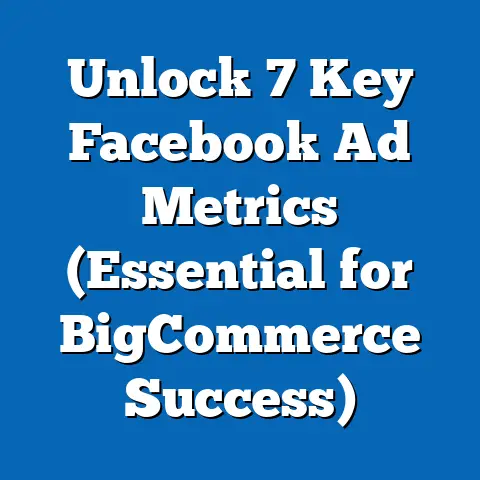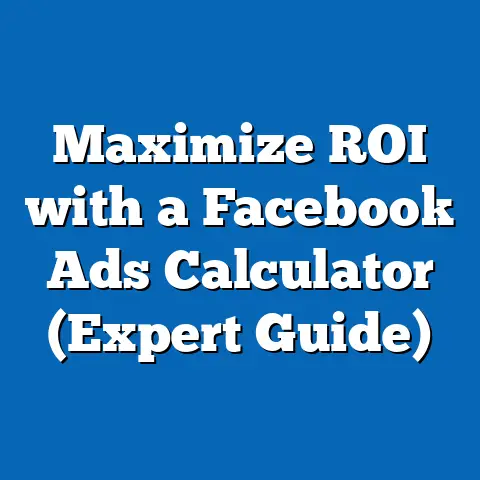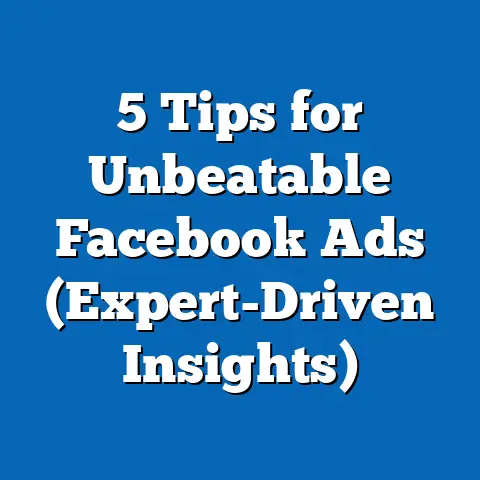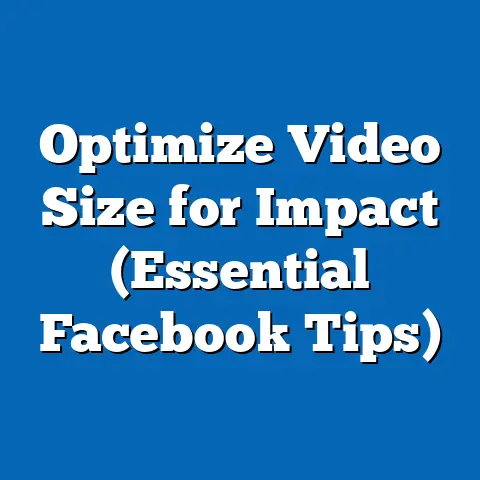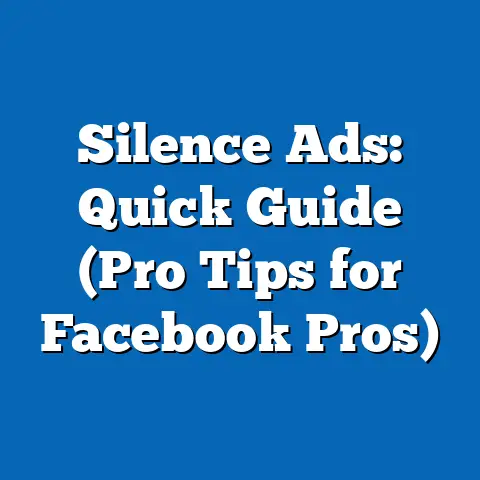Boost Engagement with Facebook App Pop-Up Ads (Pro Tactics)
Have you ever been scrolling through your Facebook feed, only to be interrupted by a brightly colored pop-up ad that somehow knows exactly what you’ve been craving? It’s almost as if your phone is reading your mind—whether it’s a deal on those sneakers you’ve been eyeing or a reminder about an event you didn’t even know you needed to attend. While pop-up ads often get a bad rap for being intrusive, when done right, they can be a game-changer for engagement and conversions in the digital marketing world.
In 2023, Facebook remains a titan in the social media landscape, boasting over 2.9 billion monthly active users worldwide, according to Statista. With such a massive audience, businesses are constantly seeking innovative ways to cut through the noise, and pop-up ads within the Facebook app have emerged as a powerful tool. Recent data from eMarketer shows that mobile ad spending is expected to reach $156 billion in 2023, with a significant portion allocated to in-app advertising formats like pop-ups due to their ability to capture attention instantly.
Section 1: Why Pop-Up Ads Matter in the Facebook Ecosystem
The Attention Economy on Facebook
In today’s digital landscape, capturing user attention is harder than ever. With users spending an average of 33 minutes per day on Facebook, as reported by DataReportal (2023), advertisers have a narrow window to make an impact. Pop-up ads, by design, interrupt the scrolling experience, forcing users to take notice—whether they click, engage, or dismiss the ad.
Research from the Interactive Advertising Bureau (IAB) indicates that pop-up ads can achieve click-through rates (CTR) of up to 2.5%, significantly higher than the 0.1-0.2% average for standard display ads. This is largely due to their immediacy and prominence on the screen. However, the challenge lies in balancing visibility with user experience to avoid annoyance.
Historical Trends vs. Current Performance
Historically, pop-up ads were synonymous with desktop browsing in the early 2000s, often criticized for being spammy and disruptive. However, their evolution in the mobile era, especially within apps like Facebook, has transformed their perception and effectiveness. According to a 2022 report by App Annie, in-app advertising formats, including pop-ups, saw a 30% year-over-year growth in engagement metrics as businesses refined targeting and creative strategies.
Today, pop-up ads on platforms like Facebook benefit from advanced algorithms and user data, allowing for hyper-personalized content. Unlike the scattershot approach of the past, modern pop-ups are tailored to user behavior, interests, and demographics, resulting in higher relevance and engagement. For instance, a 2023 study by Marketing Dive found that personalized mobile ads increase conversion rates by 27% compared to generic ones.
Section 2: Key Demographics and Behavioral Insights for Targeting
Who’s on Facebook? Breaking Down the Audience
To maximize the impact of pop-up ads, understanding Facebook’s user demographics is essential. As mentioned earlier, Pew Research Center data highlights that while younger users (18-29) are highly active, the platform also retains significant engagement from older cohorts, with 50% of U.S. adults aged 50-64 and 34% of those over 65 using Facebook regularly.
Gender distribution is relatively balanced, with 54% of users identifying as female and 46% as male, per Statista (2023). However, behavioral differences exist—women are more likely to engage with lifestyle and community-focused content, while men show higher interaction rates with tech and sports-related ads, according to a 2022 Hootsuite report.
Behavioral Patterns: When and How Users Engage
Timing and context are critical for pop-up ad success. Data from Sprout Social (2023) indicates that peak engagement times on Facebook are weekdays between 9 AM and 3 PM, with a notable spike during lunch hours (12-1 PM). Pop-ups deployed during these windows are 15% more likely to receive clicks compared to off-peak times.
Moreover, user behavior varies by device. With 98.5% of Facebook users accessing the platform via mobile devices (DataReportal, 2023), optimizing pop-ups for smaller screens is non-negotiable. Users are also more likely to engage with ads while in a relaxed state—think evening scrolling sessions—making late afternoon and early evening another strategic window for deployment.
Section 3: Pro Tactics to Boost Engagement with Facebook Pop-Up Ads
Tactic 1: Hyper-Personalization Using Facebook’s Data Tools
Facebook’s advertising platform offers unparalleled access to user data, from interests and location to browsing history and purchase behavior. Leveraging this data for hyper-personalized pop-ups can significantly boost engagement. For example, a 2022 case study by Social Media Examiner highlighted a retailer who used dynamic pop-up ads tailored to users’ recent searches, achieving a 35% increase in CTR and a 20% uplift in conversions.
To implement this, use Facebook Ads Manager to segment audiences based on specific criteria like past purchases or page interactions. Then, design pop-ups with dynamic content—such as showcasing products a user viewed but didn’t buy. Tools like Facebook Pixel can track user behavior, ensuring your ads remain relevant and timely.
Tactic 2: Craft Compelling Visuals and Copy
Pop-up ads have mere seconds to make an impression, so visuals and copy must be striking. According to a 2023 study by Nielsen, ads with bold colors and clear imagery achieve 40% higher recall rates than those with cluttered designs. Use high-quality images or short videos (under 10 seconds) to grab attention instantly.
For copy, keep it concise and action-oriented. Phrases like “Limited Time Offer!” or “Don’t Miss Out!” paired with a clear call-to-action (CTA) such as “Shop Now” can drive urgency. A/B testing different variations of visuals and text is crucial—Facebook’s own data shows that campaigns running split tests see a 10-15% improvement in performance metrics.
Tactic 3: Optimize Timing and Frequency
Overexposure can lead to ad fatigue, where users ignore or actively block pop-ups. Research from eMarketer (2023) suggests capping pop-up frequency at 1-2 per session to avoid irritation, with a 24-hour cooldown period between exposures. Additionally, timing pop-ups to appear after a user has spent at least 10-15 seconds in the app increases engagement by 18%, as they’re more likely to be in a receptive state.
Use Facebook’s ad scheduling tools to align pop-ups with peak engagement hours and monitor performance analytics to adjust frequency based on user response. For instance, if click rates drop after the second exposure, reduce frequency to maintain effectiveness.
Tactic 4: Incorporate Interactive Elements
Interactive pop-ups, such as polls, quizzes, or gamified ads, can transform passive viewers into active participants. A 2022 report by Mobile Marketer found that interactive mobile ads achieve engagement rates up to 50% higher than static ones. For example, a beauty brand running a “Spin to Win” pop-up on Facebook saw a 45% increase in user interaction and a 30% boost in email sign-ups.
To execute this, design pop-ups with simple interactive features using third-party tools like Outgrow or integrate directly via Facebook’s ad formats. Ensure the interaction aligns with your brand—e.g., a quiz for a fashion brand could ask, “What’s Your Style?”—and offers a reward like a discount code to incentivize participation.
Tactic 5: Leverage Retargeting for Higher Conversions
Retargeting is a powerful strategy for pop-up ads, focusing on users who’ve already interacted with your brand. According to a 2023 study by Criteo, retargeted ads have a 70% higher conversion rate compared to ads targeting new users. On Facebook, you can retarget users who visited your website, abandoned a cart, or engaged with previous ads.
Set up retargeting campaigns in Ads Manager by creating Custom Audiences based on specific actions. Pair this with a compelling pop-up offer—say, a 10% discount for completing a purchase—and watch conversion rates soar. A case study by WordStream (2022) showed a small e-commerce business achieving a 3x return on ad spend (ROAS) through retargeted pop-ups.
Section 4: Measuring Success and Optimizing Campaigns
Key Metrics to Track
To gauge the effectiveness of your Facebook pop-up ads, focus on metrics like CTR, conversion rate, cost-per-click (CPC), and engagement rate. According to Facebook’s 2023 advertising benchmarks, a good CTR for in-app ads hovers around 1.5-2%, while CPC averages $0.97 for most industries. Use these as baselines to evaluate performance.
Additionally, track qualitative feedback through user comments or surveys to understand sentiment. Are users finding the pop-ups helpful or intrusive? Tools like Facebook Insights and Google Analytics can provide detailed breakdowns of performance by demographic, time, and device.
Optimization Strategies
Continuous optimization is key to sustained success. Analyze data weekly to identify underperforming ads—e.g., if a pop-up’s CTR dips below 1%, test new visuals or copy. A 2023 report by HubSpot found that campaigns optimized bi-weekly saw a 25% improvement in ROI compared to those left static.
Experiment with different audience segments, ad placements, and formats. For instance, if younger users (18-24) show lower engagement, tailor content to their preferences, like using trending memes or influencers. Optimization isn’t a one-time task; it’s an ongoing process driven by data and user feedback.
Section 5: Challenges and Ethical Considerations
Balancing Engagement with User Experience
While pop-up ads are effective, they walk a fine line between engaging and annoying. A 2022 survey by Statista revealed that 73% of mobile users find frequent pop-ups disruptive, with 40% admitting to uninstalling apps due to excessive ads. To mitigate this, prioritize user experience by limiting frequency and ensuring relevance through targeting.
Privacy Concerns and Compliance
With increasing scrutiny on data privacy, advertisers must comply with regulations like GDPR (General Data Protection Regulation) in Europe and CCPA (California Consumer Privacy Act) in the U.S. Facebook has faced criticism for data misuse in the past, and a

